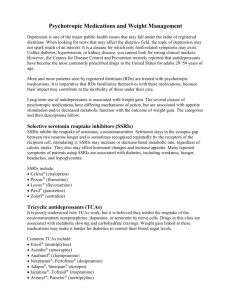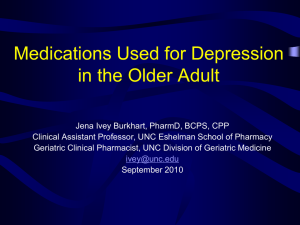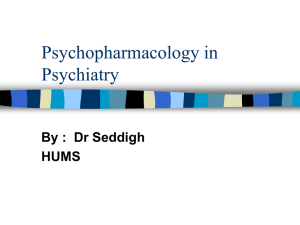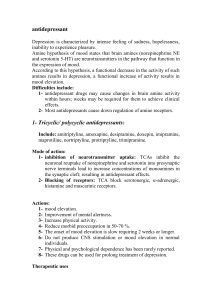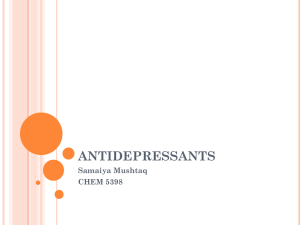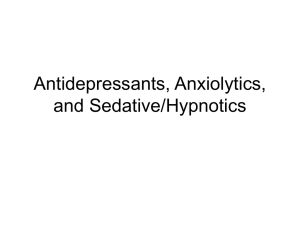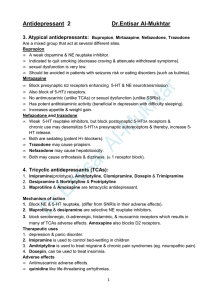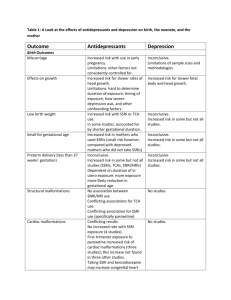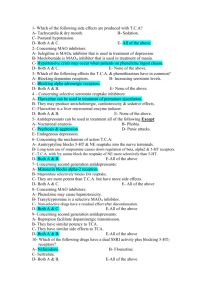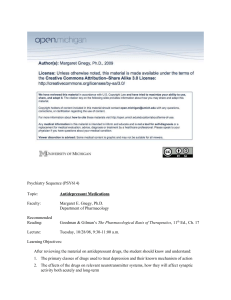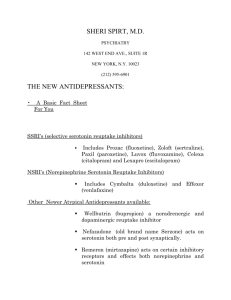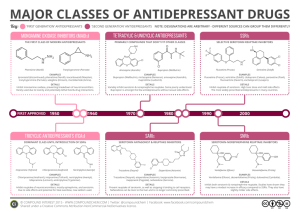Antidepressant, Anti
advertisement
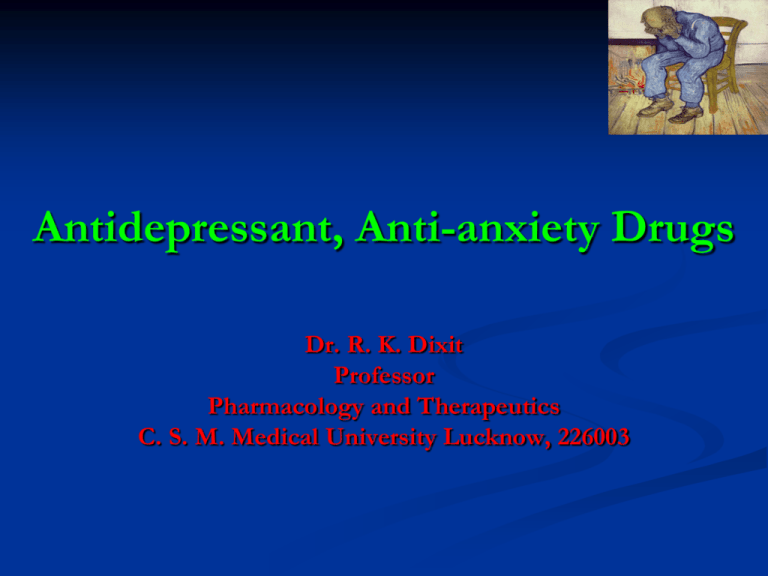
Antidepressant, Anti-anxiety Drugs Dr. R. K. Dixit Professor Pharmacology and Therapeutics C. S. M. Medical University Lucknow, 226003 Classification of Major Affective Disorders Major Affective Disorders Episodal Depression Seasonal Affective Disorder Atypical Depression Major/ Endogenous Depression Mania Bipolar depression Episodal (reactive) Depression Adverse life events. Physical illness. Drugs. Other psychiatric disorders. Reactive (episodal) Depression More than 60% of all depressions. Core depressive syndrome: feelings of misery, apathy, inadequacy, pessimism, anxiety, tension, guilt. Ugliness, Low self –esteem, Bodily complaints Withdrawn. Loss of interest in pleasurable activities. Indecisiveness, loss of motivation. Retardation of thought and action. Sleep disturbance In severe cases, it is accompanied by hallucinations and delusions. Recurrent suicidal ideation, a suicide attempt or a specific suicide plan. •significant weight change (without dieting ) •Psychomotor agitation or retardation. 1. Has a genetic component. 2. Depression can be drug-induced. 3. Depression can be drug-repressed. 4. Depression can be treated with drugs. 5. Depression can be treated with Electroconvulsive Therapy (ECT). Mania Mania alone is rare (10%) and most frequently cycles with Major/endogenous depression (Manic-Depressive Disease, Bipolar Disorder). Core Symptoms: Characterized by an elevated “high” mood. Talkative, go on-and-on about the things they will do. Increased self-esteem. Auditory hallucinations. Decrease need to sleep. Expensiveness, unnecessary buying. Lack judgment, Supermen The precise cause of affective disorders remains elusive. Evidence implicates alterations in the firing patterns of a subset of biogenic amines in the CNS, Norepinephrine (NE) and Serotonin (5-HT). Activity of NE and 5 -HT systems?. Almost all NE pathways in the brain originate from the cell bodies of neuronal cells in the locus coereleus in the midbrain, which send their axons diffusely to the cortex, cerebellum and limbic areas (hippocampus, amygdala, hypothalamus, thalamus). Mood: -- higher functions performed by the cortex. Cognitive function: -- function of cortex. Drive and motivation: -- function of brainstem Memory and emotion: -- function of the hippocampus and amygdala. Endocrine response: -- function of hypothalamus. Serotonin System As with the NE system, serotonin neurons located in the pons and midbrain (in groups known as raphe nuclei) send their projections diffusely to the cortex, hippocampus, amygdala, hypothalamus, thalamus, etc. --same areas implicated in depression. This system is also involved in: • • • • • Anxiety. Sleep. Sexual behavior. Temperature regulation. CSF production. Blocked by Blocked antidepressants by antidepressants Serotonin receptors 5–HT1 subtypes 5–HT1A, 5–HT1B, 5–HT1D, 5–HT1E, 5–HT1F primarily responsible for the therapeutic (antidepressant) effects of increased intrasynaptic serotonin 5–HT2 subtypes 5–HT2A, 5–HT2B, 5–HT2C primarily responsible for the toxic effects of increased intrasynaptic serotonin Serotonin receptors Over all 14 types divided in to 1, 2, 3, and 4-7 family All are G-protein coupled receptors except 3 1- decreases cAMP while 4-7 increase 3- ligand gated cation channel Alternative Therapies No way of a priori knowing which therapy will be best for a patient. Light Therapy Psychological Treatment ECT (patients with suicidal tendency and for quick action) St. John’s Wort (Plant) Antidepressants TCAs SSRIs TCAs MAOIs MAOIs TCAs MAOIs maprotiline MAOIs MAOIs SSRIs Venflaxine MAOIs Reversible inhibitor of MAO-A (RIMAs) •CM Moclobemide ,Clorgyline A •RITA-Don't- Copy (Isocarboxacid, phenelzine, tranylcypromine.) N T •Exams-For-PCS •MAD-Boy-turned-violent I Tricyclic antideprssants D (TCAs) E NA + 5 HT reuptake inhibitor Predominantly NA reuptake inhibitor P Imipramine, Amitriptyline Desipramine, Nortriptyline R Amoxapine, Reboxetine Trimipramine, Doxepin E S Dothiepin, Clomipramine S A N T Selective serotonin reuptake Atypical antidepressants S inhibitors (SSRIs) Trazodone, Mianserine Fluoxetine, Fluvoxamine Mirtazapine, Venlafaxine Duloxetine,Tianeptine Paroxetine, Sertraline Amineptine, Bupropion Citalopram, Escitalopram Mechanism of Action 1. Inhibition of MAO enzymes. (MAOIs). 2. Inhibition of NE and 5-HT reuptake. (TCAs, SSRIs, Newer TCAs). A T Y P I C A L 3. Prominent alpha blocking and weak 5-HT antagonists. (Nefazodone, trazodone,) 4. Serotonin and noradrenalin reuptake inhibitor (SNRIs) (venlafaxine, duloxetine) 5. Noradrenergic and specific serotonergic antidepressants (NaSSA) (Mirtazapine) 6. Inhibitor of Dopamine and Noradrenalin (Bupropion) 7. Blockade of pre-synaptic alpha 2 receptors (Mianserin) 8. Increases rather than inhibiting 5-HT uptake (Tianeptine, Amineptine) MAO ( monoamine oxidase) an enzyme Two types MAO –A -Peripheral adrenergic nerve endings -Intestinal mucosa -Human placenta -Liver -Serotonin , Noradrenalin and dopamine -Inhibited by MAO-B A-B moclobemide and clorgyline -brain ( basal ganglia) -Platelets -Liver -Deaminates dopamine -Inhibeted by selegiline (deprenyl) C-D Isoniazide, iproniazide, phenelzine, isocarboxazide,tranylcypromine were non selective and irreversible inhibitors (Hit and run drugs) used previously but not used now due to drug drug and drug food interactions. Linezolide (new drug against MRSA) Cheese and serotonin syndrome Nonselective MAOIs not favorable Cheese Reaction Cheese, beer, wine, meat, fish, yeast, (contain large amount of tyrammine and other indirectly acting amines) Hypertensive crises, CVA Medical Emergency Due to irreversible block of MAO These escape degradation in intestinal wall and liver Reach to circulation Displace large amount of noradrenalin from loaded nerves Tt. I.V. Phentolamine, Prazosin Nonselective MAOIs not favorable Cold and Cough medicines contain Ephedrine (Same result as cheese reaction) Levodopa- excitement and hypertension Tricyclic antidepressants- excitement, rise in BP, temperature Reversible inhibitor of MAO-A (RIMAs) Moclobemide Reversible and selective MAO-A inhibitor Short duration of action Competitive enzyme inhibition Tyramine is able to displace it Cheese reaction is less likely Devoid of anticholenergic, sedative, cognitive, cardiovascular effects Good for elderly with heart diseases Tricyclic Antidepressants (TCAs) Imipramine represents the class (Prototype) Inhibit monoamine reuptake (serotonin and noradrenalin) Increase the concentration of synapse and potentiate the action (therapeutic effects) Other receptors acted (Adverse effects) Muscarinic- Anticholinergic side effects (dryness etc.) # Alpha- alpha blocking actions (postural hypotension etc.) # Histamine-Antihistaminic (sedation) # Serotonin and NA at Dopamine- antipsychotic (amoxapine, maprotiline) TCAs actions (CNS) In Normal person - Tiredness Light-headedness Sleepiness Difficulty in thinking Difficulty in concentration, Gait disturbances Provoke anxiety Unpleasant -Sedation immediately -Elevation of mood (2-4Weeks) -Suppresses REM prolongs total sleep duration - - In Depressed Lower seizure threshold and produce convulsions in overdose Don’t carry abuse potential, Development of dependence is less TCAs uptake blockade is not directly responsible for antidepressant action? Uptake blockade occurs quickly but antidepressant action occurs after months Initially Pre synaptic alpha 2 and 5-HT1 auto receptors are activated by increased amount of NA and Serotonin in synaptic cleft resulting in decreased firing But on long term desensitize and down regulation of these receptors and induce adaptive changes in the number and sensitivity of receptors and amine turnover leading to enhanced NA and Serotonin transmission required for antidepressant action. TCAs on other systems ANS CVS Potent anticholinergic (dry mouth, blurring of vision,, constipation, urinary hesitancy) Weak alpha 1 blocking (postural hypotension, impairment of ejaculation,) H1 antihistaminic (sedation) Tachycardia Postural hypotension Cardiac arrhythmias (T wave suppression or inversion) due to intra ventricular conduction interference due to NA and Anti cholinergic actions Tolerance to Anticholinergic and hypotensive actions develop latter on TCAs (Pharmacokinetics) Good oral absorption Highly bound to Proteins (plasma and tissue) Metabolized in liver (oxidation, glucuronide conjugation and CYP2D6, CYP3A4, CYP1A2 Many active metabolites may be produced Mostly can be given once a day (at bed) Have Therapeutic Window phenomenon (50-200ng/ml of imipramin) TCAs Adverse effects Anticholinergic- dry moth, bad taste, constipation, epigastric fullness, urinary retention (more common in elderly male), blurred vision, palpitation Sedation, mental confusion, weakness Increased appetite and weight Sweating, fine tremors Precipitation of seizures Postural hypotension Cardiac arrhythmias Rashes and jaundice TCAs (Acute Poisoning) Usually suicidal attempt Presents as Excitement delirium, Anticholinergic symptoms like atropine poisoning Muscle spasm Convulsions Respiratory depression Coma Treatment Gastric lavage I.V. line Oxygen Maintenance of BP and Temperature Diazepam iv Propranolol / lignocain TCAs (Interactions) Potentiation of sympathomimetics (direct acting) Reduce action of sympathomimetics (indirect acting) Reduce antihypertensive action of guanethidine and clonidine ( by preventing their transport in to neurons) Potentiate other CNS sedatives SSRIs inhibit metabolism of TCAs With MAO inhibitors dangerous hypertensive crisis with excitement and hallucinations Retard the absorption of other drugs Phenytoin, phenylbutazone, chlorpromazine, aspirin, displace TCAs and produce toxicity Phenobarbitone induce metabolism and inhibit the effect of the drug Miscellaneous Amoxapine Tetra cyclic compound Blocks D2 reuptake also Has mixed antidepressant and neuroleptic effects Good for psychotic depression Reboxetine Selective NA reuptake blocker Weak action on 5HT mechanism Anticholinergic effects are minimal Selective Serotonin Reuptake Inhibitors (SSRIs) Limitations of TCAs Anticholinergic effects Alpha blocking action Cardio toxicity Sedation, seizures ppt Low safety margin Weight gain Therapeutic window Overdose poisoning common Lag of 1 month period Incomplete response to Tt Answers may be given by SSRIs Selectively inhibit membrane associated SERT (serotonin transporter) More tolerability and better acceptability Used in depression as well as in OCD, phobias No sedation, No seizure ppt No alpha blocking action Less chances of arrhythmia No weight gain Now 1st choice for OCD, Panic disorders, Social Phobia, Eating disorders, Premenstrual syndrome, Post traumatic stress Important points TCAs have slightly more efficacy Some patients not responding to TCAs may respond to SSRIs, SSRIs preferred in prophylaxis of recurrent depression In severe depression TCAs appear to be more efficacious Individual compounds Fluoxetine Prototype of SSRIs Longest acting Paroxetine Short acting More GI side effects Fluvoxamine Short acting Commonly used in indoor patients Sertraline Less chances of drug interactions due to low potency to cause cytochrome enzyme depression Citalopram Escitalopram •Similar to sertraline but should be avoided in patients attempting suicide •Active enantiomer of citalopram side effects are less SSRIs Side effects Gastric upset Nausea Interfere with ejaculation Nervousness Restlessness Insomnia Anorexia Headache Diarrhea Epistaxis Ecchymosis Others Inhibit cytochrome enzymes and elevate the plasma level of other drugs Other serotonergic drug ( MAOIs) is taken may precipitate Serotonin Syndrome manifesting as agitation, restlessness, sweating, twitching, convulsions Atypical Antidepressants Trazodone Blocks 5-HT uptake Has prominenent alpha blocking Weak 5-HT2 antagonistic No anticholinergic effect Bradycardia Has anxiolytic action also Prolonged and painful penile erection (priaprism) Mianserin Unique not inhibit NA and 5-HT uptake Blocks pre-synaptic alpha 2 receptors increases release and turnover of NA Antagonist at serotonin 2, 1c, and H1 receptors Has sedative effect Damages liver and bone marrow (Reserve drug) Atypical Antidepressants Tianeptine / and Amineptine Increases rather inhibiting 5-HT uptake Neither sedative nor stimulant Effective in anxiodepressive states Venlafaxine / Duloxetine Mirtazapine (NaSSA) Noradrenergic and specific serotonergic antidepressant Blocks alpha 2 auto receptor (on NA neuron) and hetero(on 5-HT neuron) receptors increasing both NA and serotonin release. SNRI selective in action Faster onset of action Increases BP Duloxetine increases uretheral tone used in urinary incontinence ( over active bladder) Bupropion Inhibits DA and NA uptake has excitant effect Used to reduce smoking Antidepressant uses Depression (ECT may be needed in severely depressed and patients having suicidal tendency) Bipolar affective disorders TCAs and lithium or SSRIs with lithium or valporate/ lamotrigine SSRIs with atypical antipsychotic in psychotic depression Obsessive compulsive disorders (SSRI and Clomipramine) Eating disorders Anxiety disorders Neuropathic pain Attention deficit hyperactivity disorder in children Enuresis- (Imipramine 25mg at night) Overactive bladder (stress incontinence) Migraine prophylaxis Pruritus (Topical doxepin) Antianxiety Drugs Anxiety - emotional state - - Unpleasant Associated with uneasiness Discomfort Fear Undefined threat Fear about future Some amount of anxiety is must for progress When it becomes excessive, disproportionate, hampers performance then only needs treatment Antianxiety Drugs Drugs producing restful state of mind without interfering with normal mental or physical functions. Have no effect on thought control Don’t produce extra pyramidal side effects Can Produce physical dependence May Have abuse potential Don’t selectively block conditioned avoidance response in animals Have anticonvulsant activity Antianxiety Drugs Benzodiazepine Diazepam Chlordiazepoxide Oxazepam Lorazepam Alprazolam Azapirones Others PHO/BIG/DOCLA Buspirone Gepirone Ispapirone Beta blocker- Propranolol AntihistaminicsHydroxyzine SSRIs and other antidepressant drugs Benzodiazepines Relieve anxiety at low dose ( higher dose induce sleep and impair performance ) Selective taming effect More selective to limbic system Have low side effects in Antianxiety dose Lorazapam and clonazepam IM for psychotic and manic patients Act by facilitating GABAergic transmission Benzodiazepine MOA Cl α subunit Diazepam + DMCM – Flumazenil- 0 Extra-tracellular Others δεθπ γ subunit Barbiturates Intracellular GABA β subunit GABA- A Receptor Cl More Clintracellular more polarized more refractory Benzodiazepines Adverse effects Sedation Light headedness Psychomotor impairment Cognitive impairment Vertigo Confusional state Increased weight Impaired sexual functions Potential to produce dependence All are almost similar selection is empirical Benzodiazepines (Individual drugs) Chlordiazepoxide First BZD Long lasting effect Chronic anxiety Oxazepam Diazepam Has two phase of metabolism Broken in to active metabolites Long duration of action Lorazepam Polar compound Less lipid soluble Penetration In brain is slow Slow entry in brain No active metabolite No active metabolite Used in short lasting anxiety IM state Alprazolam- high potency, mood elevating in depressed pt. less drowsiness Buspirone Does not produce sedation, cognitive impairment, Does not interact with BZD receptor or modify GABAergic transmission No tolerance No physical dependence No muscle relaxant No anticonvulsant property Buspirone Relieves mild to moderate generalized anxiety Effects develop slowly (not used for acute) Partial agonist on 5HT1A (pre-synaptic) and antagonist on 5HT postsynaptic receptors Presynaptic auto-receptors stimulated leading to reduced activity of dorsal raphe serotonergic neurones Also has weak D2 blocking effect Hydroxazine H1 antihistaminic Sedative, anti -emetic and spasmolytic Anti - Pruritus Propranolol Reduces sympathetic symptoms like rise in BP, Tremors, sweating etc. Performance or situational anxiety (like examination fear, social phobia, public lecture) Questions Classify antipsychotic drugs Classify antidepressant drugs Pharmacological actions of chlorpromazine Pharmacological actions of amitriptyline Drug indued parkinsonism MOA of antipsychotic MOA of antidepressants Lithium Questions Drug of choice of cheese reaction-Phentolamine Moclobemide is reversible and selective MAO-A inhibitor All antidepressants don’t inhibit DA uptake except amoxapine, maprotiline, Bupropion Antidepressants don’t carry abuse potential SSRIs are inhibitor of CYP enzymes Serotonin syndrome Trazodone – may produce priaprism due to high α1 blocking property Mianserin unique not inhibiting NA or 5HT but blocks Pre-synaptic α2 receptors Tianeptine, Amineptine - unique increase 5-HT uptake Venlafaxine, Duloxetine – SNRI Mirtazapine- NaSSA- blocks α2 auto and hetro receptors and enhance NA and 5HT release Nocturnal enuresis- Imipramine Benzodiazepines- GABA facilitatory Buspirone- partial agonist at 5HT1A autoreceptors,antagonist at 5HT1A postsynaptic DOC of performance or situational anxiety- B-blockers Thanks
